|
17 C. Iberian Organ Music
Correa, Bruna & Braga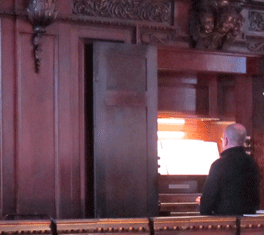
Andrew Benson-Wilson
St Giles-in-the-Fields, 1st November 2011
This was another fascinating recital of early organ music , with works from 17th century Spain and Portugal by the late-Renaissance master from Seville, Francisco Correa de Arauxo and Pablo Bruna (the "blind man of Daroca", b.1611), ending with the extraordinary Battalha de 6 Tom by the Portuguese composer, Antonio Correa Braga.
Andrew Benson-Wilson returned to play another programme on the 2006 William Drake rebuild of the 1856 Gray and Davison organ, which incorporates much 17th century pipework and, with judicious registration choices, is probably the best instrument in Central London for the repertoire in which he specialises.
These tientos (toccatas) require to be played with ornamentation and rhythmic flexibility, often with "notes inégales". Some of them demand considerable virtuosity, and the ending of the recital with Braga's spectacular Battalha de 6° Tom was duly exciting.
Peter Grahame Woolf
Previous London organ recitals by Andrew Benson-Wilson reviewed in Musical Pointers:
Buxtehude & before
Seventieth Century German Organ Music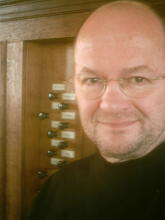
Tunder Praeludium In G Minor, Chorale Fantasia and In Dich Hab Ich Gehoffet
Praetorius Hymnus: Te Lucis Ante Terminum
Scheidemann Benedicam Dominum In Omni Tempore
Weckmann Praeambulum Primi Toni A 5 and Ach Wir Armen Sunder
Buxtehude Te Deum Laudamus
Andrew Benson-Wilson (organ)
St John's, Smith Square 3 June 2010
This lunchtime concert was perhaps the first to explore the possibilities to simulate early organ sound on St John's versatile Sainsbury Concert Organ (Klais of Bonn - 1993).
Andrew Benson-Wilson, author of "The Performance of Early Organ Music", is familiar with 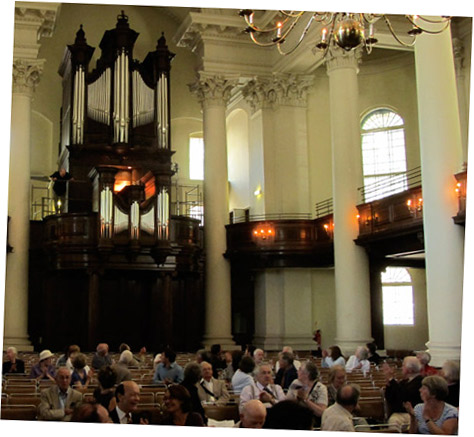 the surviving instruments in North Germany. His recital proved to be one of the most rewarding organ recitals heard in London in years, an enthralling experience. My previous encounter with the SJSS Klais had been discouraging; a concert including the Reubke sonata, its climaxes so loud that I had to cover my ears for relief... the surviving instruments in North Germany. His recital proved to be one of the most rewarding organ recitals heard in London in years, an enthralling experience. My previous encounter with the SJSS Klais had been discouraging; a concert including the Reubke sonata, its climaxes so loud that I had to cover my ears for relief...
In his carefully compiled programme notes, Benson-Wilson (London critic for Early Music Review) reminded us that German organs of the period were "of monumental size" - Weckmann played a Hamburg one with 71 stops, c.50% more than St John's in London, its pedal division twice the latter's size. The registrations applied today were based on contemporary references and known specifications of those organs, and embraced a kaleidoscope of colours, with the sound full when appropriate but never ear-hurting.
Benson-Wilson played with secure authority and rhythmic command, aided by using SJSS's electronic sequencer for precise changes of registration.
The climax of the recital was Buxtehude's longest keyboard work, c. 15 minutes, ranging widely within North German Chorale Fantasia and stylus phantasticus traditions.
For listeners fairly near the front of St John's, pleasure was enhanced by following Benson-Wilson's 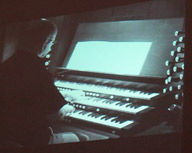 hands projected on a small screen. The black & white image was not as clear as one might reasonably hope with today's technology; it showed his knees moving, but not the feet! On my snap above, you can discern the diminutive figure of Andrew Benson-Wilson up in the organ loft acknowledging applause, the audience turning round to see him. hands projected on a small screen. The black & white image was not as clear as one might reasonably hope with today's technology; it showed his knees moving, but not the feet! On my snap above, you can discern the diminutive figure of Andrew Benson-Wilson up in the organ loft acknowledging applause, the audience turning round to see him.
The distancing of player from listeners in many churches probably militates against the popularity of organ recitals, frequently given in London, especially in City churches, but often poorly attended; also, q.v. "ugly noise at an ear-endangering decibel level".
Andrew Benson-Wilson should be invited back to St John's next season to continue exploring his specialised repertoire there.
Peter Grahame Woolf

Bach at Grosvenor Chapel and St Giles in the Fields
Chorale Preludes from Clavierubung III Grosvenor Chapel November 9th 2010
Kyrie, Gott Vater in Ewigkeit Allein Gott in der Höh sei Ehr Dies sind die heilgen zehn Gebot Wir glauben all an einen Gott Vater unser im Himmelreich Christ, unser Herr, zum Jordan kam Aus tiefer Not schrei ich zu dir Jesus Christus, unser Heiland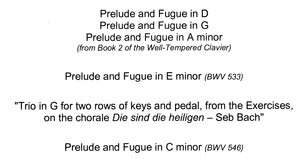
Grand studies – The English Bach Revival St Giles in the Fields, November 2nd 2010
Andrew Benson-Wilson - organ
An hour of music at lunchtime is widely available in central London as elsewhere, and worth seeking out. Two rewarding Bach recitals on small London organs were given by Andrew Benson-Wilson, a specialist in early organ music, during November.
Both recitals were preceded by short spoken introductions by A B-W himself and he provided us with comprehensive notes he'd prepared to put us in the right context. 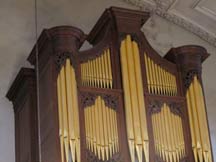
William Drake's organ at Grosvenor Chapel (1991) was built within the original 1732 case. Full-toned but never overwhelming, it allowed for a lucid exposition of eight Chorale Preludes, which
Andrew Benson-Wilson introduced as enigmatic and complex, some of them of enormous intensity, Vater unser in Himmelreich combining those two features.
Only very few came to listen, as is often the way with organ 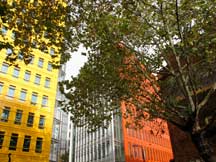 recitals, but it had been a very different scene the previous week at St Giles, an oasis of peace in one of the busiest parts of central London, with garish new skyscrapers just outside. recitals, but it had been a very different scene the previous week at St Giles, an oasis of peace in one of the busiest parts of central London, with garish new skyscrapers just outside.
St Giles has built up a loyal audience, which was greeted in the friendliest way and with hot drinks on arrival.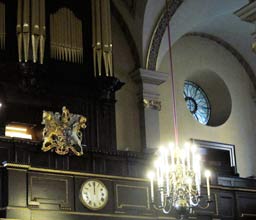
The English organ of the late 18th & early 19th C didn't have pedals, and many of the pieces played then and chosen now were not intended specifically for organ, but worked well on this instrument [Gerard Smith jnr/William Drake].
Andrew B-W's programme of works which organists had played during the English Bach revival was of particular interest to those of us who are not organists.
Some are very familiar to amateur pianists and I enjoy playing several of the "48" on clavichord, which may help to explain why I did not empathise with a listener who complained afterwards that the delectable St Giles' instrument "didn't fill the space"...
These performances drew you in to the music, rather than shouting it out on a scale otherwise only to be expected from full Symphony 0rchestras (c.f. musicalpointers.09/OrganRecitalsX3).
The programme demands to be recorded for CD there; St Giles is extraordinarily quiet and free from traffic noise even in the middle of the day.
PGW
|



